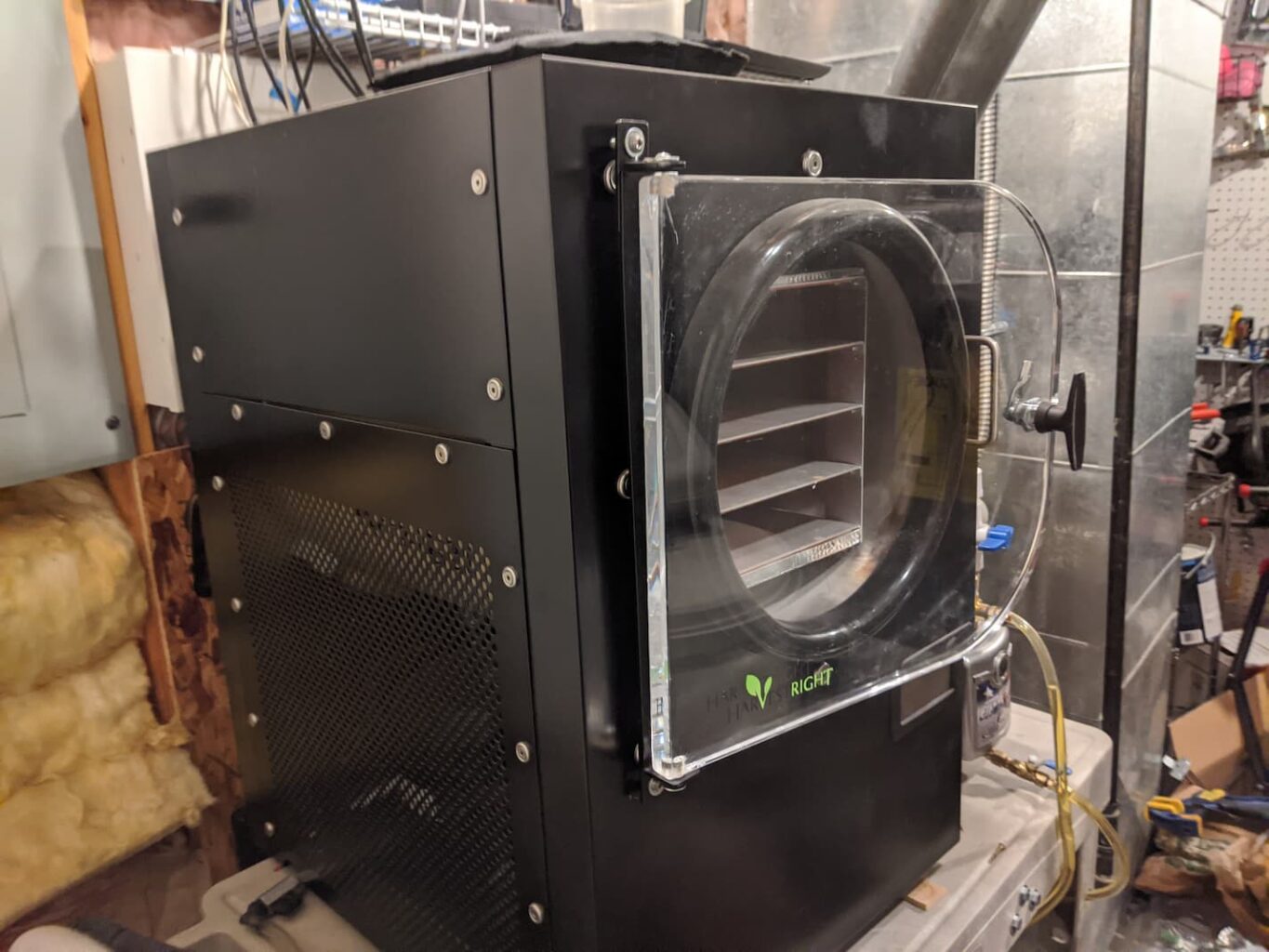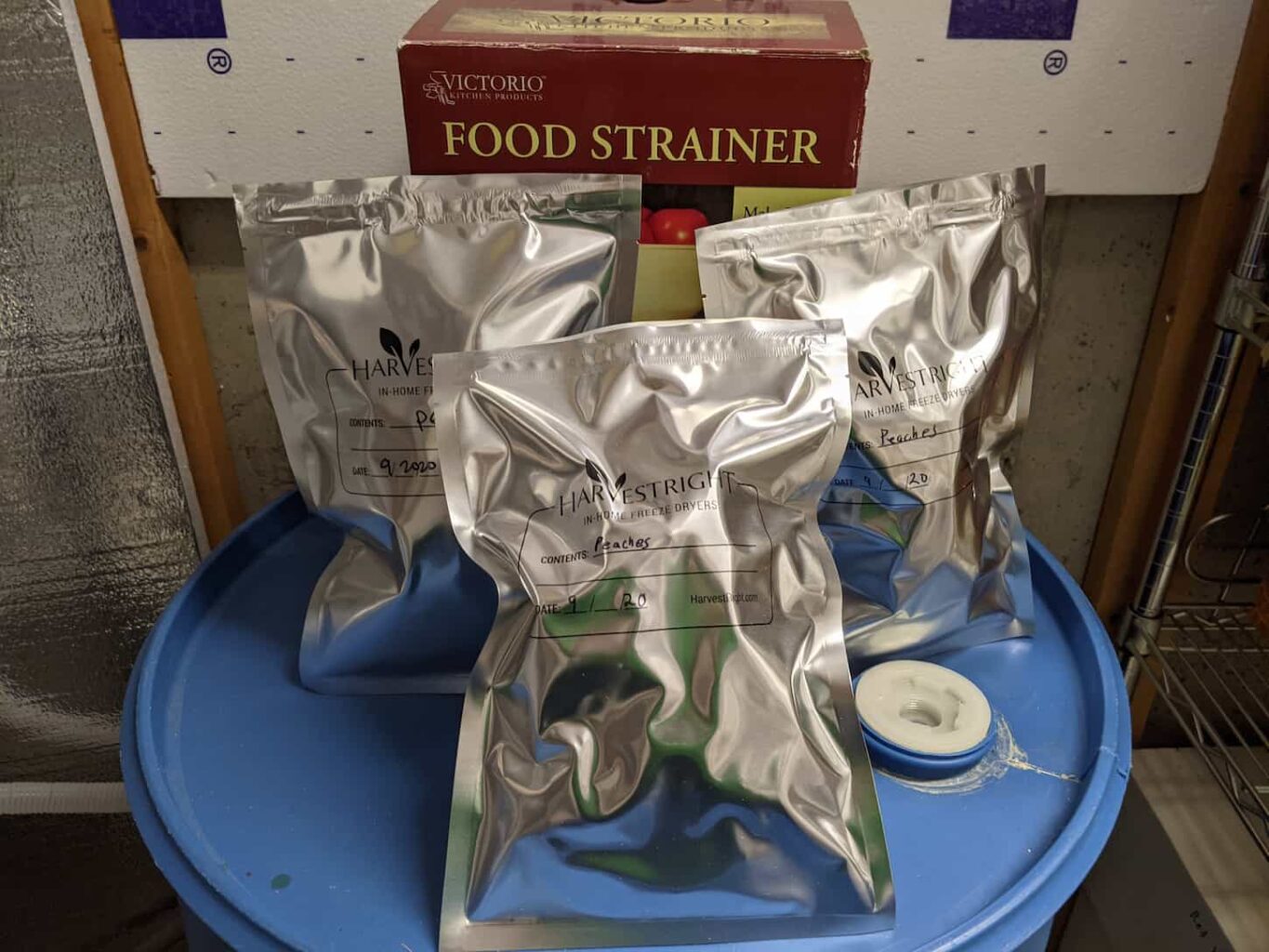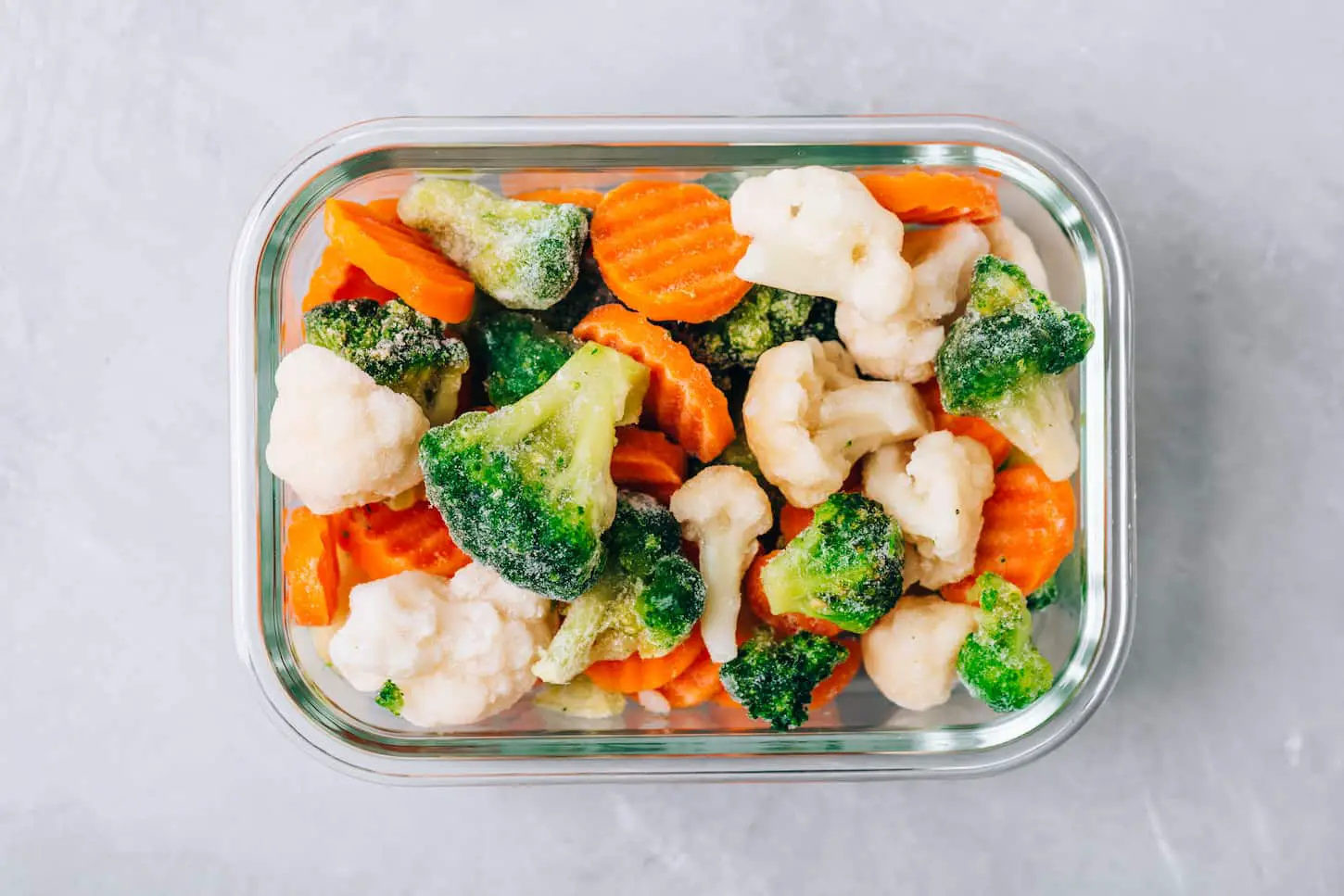Running a freeze dryer over the last five years (and working with our neighbors who’ve had theirs for close to 10 years of snow), we’ve learned an awful lot about freeze-drying and how much it costs to run them.
Running a freeze dryer costs an average of $2.20 per day to run the freeze dryer, or $2.75 per day ($83.65 per month) including the cost of electricity, storage materials, and regular maintenance. This is on top of the price of the freeze dryer, which varies from around $2,195 to $5,000+.
Now that everything is set up, we’ve got a pretty sweet, efficient gig going with our freeze-dryer. And we can store our food for pennies compared to what we’d spend at the store buying ready-packaged freeze-dried goods.

How Much Does It Cost to Buy a Freeze Dryer?
A freeze dryer costs $2,195 for the smallest option with an oil pump and up to $5,090 for the largest machine with a premium, oil-free pump. All options include the basic accessories needed to get started freeze-drying.
Freeze dryers come in different sizes, and the dimensions determine the price – the bigger the freeze dryer, the higher the cost. This is because they come with various properties installed in them. A freeze dryer may have a large up-front cost, but it is a versatile tool that can do things your average refrigerator, freezer, or dehydrator can’t do.
The good news is that, when you buy from Harvest Right (which I highly recommend), the up-front cost for the freeze-dryer also includes all of the things you need to get started:
- The freeze-dryer unit (you select the size you need)
- Vacuum pump (you choose which kind)
- Stainless steel trays (set of 4 for small and medium, the large comes with 5)
- Freeze-drying owner’s guide
- Impulse sealer (to seal the Mylar bags)
- Oxygen absorber starter kit (50 counts)
- Mylar bags (50 counts)
Even so, here’s how much it costs to get the freeze-dryer sizes with various oil pumps. These are the standard prices as of the publishing date, so you may be able to find better prices when there’s a sale.
| Pump | Small | Medium | Large |
|---|---|---|---|
| Oil Pump | $2,195 | $2,895 | $3,595 |
| Premier Oil Pump | $2,590 | $3,290 | $3,990 |
| Oil-Free Pump | $3,690 | $4,390 | $5,090 |
What’s the best brand of freeze dryer to buy?
Harvest Right is the best brand for freeze dryers; they have created the world’s best and most affordable freeze dryers that come with a three-year warranty limit.
This company continues to make upgrades to the machine and has made it possible for people to preserve and have a wide range of quality food for a long time. There’s yet to be a technology that does close to what their invention does.
Here are a few tables to show you important data about each size model.
| Model | Food Per Batch | Regular Price |
|---|---|---|
| Small | 1-1.5 gallons (4-7 pounds) | $2,195 – $3,690 |
| Medium | 1.5-2.5 gallons (7-10 pounds) | $2,895 – $4,390 |
| Large | 3.5 gallons (12-16 pounds) | $3,595 – $5,090 |
And here’s important info about what accessories each size comes with as a standard package.
| Model | Accessories |
|---|---|
| Small | 3 Stainless steel trays, Vacuum Pump, Vacuum Pump Oil, Oil Filter, Guide to Freeze Drying, Mylar Bags, Oxygen Absorbers, and Impulse sealers. |
| Medium | 4 Stainless steel trays, Vacuum Pump, Vacuum Pump Oil, Oil Filter, Guide to Freeze Drying, Mylar Bags, Oxygen Absorbers, and Impulse sealers. |
| Large | 5 Stainless steel trays, Vacuum Pump, Vacuum Pump Oil, Oil Filter, Guide to Freeze Drying, Mylar Bags, Oxygen Absorbers, and Impulse sealers. |
Need more information? Read my new size guide to freeze dryers here: Harvest Right Freeze Dryer Size Comparison Guide.

Can you buy a used freeze dryer?
It is possible to purchase pre-owned freeze dryers. There are sufficient freeze-dryer owners who decide to sell (usually to upgrade their unit) that there are used units for sale via the freeze-drying forums and Facebook groups.
It wouldn’t surprise me to see dedicated second-hand stores for freeze dryers pop up as freeze-drying becomes more popular.
If you’re willing to buy a used unit, there may be a better price available for you. Harvest Right sometimes has returned units for sale (after they’ve been refurbished).
You can also buy units from places like EquipNet, Alibaba, Machino, and Frain which offer freeze dryers in different capacities and models. However, I haven’t tested any of those and would definitely recommend that you stick with Harvest Right.
Can you buy an industrial freeze dryer?
Industrial freeze dryers are easily accessible in online stores including Harvest Right, though industrial freeze dryers are far more expensive than freeze dryers specifically for home use.
Industrial freeze-drying machines are widely used because of their greater freezing capacity and are used primarily following at research centers. They provide the largest process space, allow for an aggressive freeze-drying cycle, and have good functionality and performance.
These machines usually cost more than a pre-owned freeze dryer and a Harvest Right freeze dryer combined.
So if you’re just buying a freeze-dryer for home use, stick to a Harvest Right home freeze-dryer. The price is a ton better – and you can click here to shop current Harvest Right sales.
How Much Does it Cost To Ship a Freeze-Dryer?
If you live in the contiguous United States and are buying a new freeze-dryer from Harvest Right, then shipping is currently included in the base price of your freeze-dryer.
But if you live in Alaska, Hawaii, or anywhere else? Then shipping will cost you extra. Based on the size of the unit, I did some calculations for freight rates.
| Model | Shipping cost |
|---|---|
| Harvest Right small freeze dryer | $131.70+ |
| Harvest Right medium freeze dryer | $161.70+ |
| Harvest Right large freeze dryer | $203.70+ |
Keep in mind that these can change – so here are the numbers (dimensions and weights) you can use to calculate shipping.
| Model | Dimension | Weight |
|---|---|---|
| Harvest Right small freeze dryer | 26″W x 36″D x 41″H. | 139 pounds |
| Harvest Right medium freeze dryer | 26″W x 36″D x 45″H | 212 pounds |
| Harvest Right large freeze dryer | 29″W x 38″D x 48″H. | 253 pounds |
These prices will vary depending on if you’re buying new, used, shipping yourself, and other factors. It can also vary depending on if you use a freight service or if you’re going to use a premium shipping service like UPS or FedEx.
So be sure to shop around before you commit to one shipping option.
How Much Does It Cost to Run a Freeze Dryer Load?
Based on the national average, the cost to run a freeze dryer load is about $3.49 for a big load and $1.57 for a smaller load.
The average kilowatt-hour cost in America is 12 cents per hour. Harvest Right freeze dryers use 45 watts to be plugged in. The small and medium-sized freeze dryers use a standard 110-volt outlet, making the cost about $1.00 – $2.80 per day to use the freeze-dryer.
If you have a large freeze dryer, keep in mind that while it uses a 110-volt outlet, it requires a 20 amp dedicated outlet. So it should use about the same amount of electricity and have similar costs. It may vary some, but the numbers I’ve compared with friends who have a large size are close enough to ours that it’s fine to use these numbers.
The cost of a freeze-dryer load depends on the area you are living in. This is because the electricity bill can skyrocket at any time of the year.
Want to increase the freeze dryer’s insulation to keep costs down? Read this article next on how to do that: Can You Make Your Own Freeze Dryer Door Pad or Pillow?
How much energy does it take to run a freeze-dryer?
| Freeze Dry Cycle | Hours | Energy |
|---|---|---|
| First cycle | 1 hour | 56 kWh |
| Drying | 9 hours | 3.54 kWh |
| Final dry | 33 hours | 20.1 kWh |
| Complete cycle | 47 hours | 29.9 kWh |
How much electricity does a freeze dryer use?
On average, freeze dryers use about $2.20 worth of electricity per day while running. Depending on local electricity costs, this may vary up to $5 per day, depending on the cycle.
| Freeze dry cycle | Hours | Electricity |
|---|---|---|
| First cycle | 1 hour | 5.2 amps (290 watts) |
| Drying | 9 hours | 11.3 amps (607 watts) |
| Final dry | 33 hours | 14.6 amps (1348 watts) |
| Complete cycle | 47 hours | 19.8 amps (1414 watts) |
The total cost of electricity per load, using this data, averages $3.85 (plus food) per load.
Now, we got all of these numbers by measuring how much electricity our medium-sized freeze dryer actually uses. I then used data from a year’s worth of electricity bills to calculate these numbers. That way, the prices could be normalized over a year’s worth of electricity costs.
But if you’d like to know your own specific costs for your freeze dryer, then you can use a simple tool to monitor your electricity usage. Then, you can use those numbers with your local electricity costs to figure out exactly how much it costs you to run your freeze-dryer.
An electricity meter can be plugged into the freeze-drying machine and can give data on the volt, amps, wattage, hertz, and the total kilowatt-hours consumed while the freeze-dryer is running. Here’s a list of excellent electric usage monitors to help you manage power consumption:
- REED Power Meter (R5090): this is an easy-to-use meter with a built-in backup battery and allows you to save your measurements. It accurately measures voltage, current, watts, frequency, power factor, energy consumption, and the total cost.
- Trickle Star Plug-in Energy Monitor: This records the overall power consumption during the day or multiple days. It is a brilliant device with a timer to help you control your power usage.
- Sense Energy Monitor: This is more advanced than any other power monitor as it requires a professional to install it into your home. After installing it into your electric panel, you follow up by downloading the Sense app on your phone and following the on-screen instructions. The app gives you an insight into your freeze dryer’s power usage.
We have a basic power meter (like the REED meter) that we used to measure our freeze dryer’s power draw and usage.
Is freeze-drying energy-efficient?
Freeze-drying uses more energy up-front to prepare the food than other food storage methods, but the stored food also lasts for many years longer than other storage methods with much less overall energy usage required.
So if we look at it short-term, then freeze-drying isn’t energy efficient at all. However, if we compare the amount of energy required to store food in a freezer for a year compared to shelf-stable freeze-dried foods? Then it’s very energy efficient!
For comparison, an average refrigerator uses about one to two kilowatt-hours per day.
It would take storing food for anywhere from 24-47 days in a fridge to pay off the energy used in freeze-drying a single load.
Energy consumption is generally frowned upon, but the advantages of freeze-drying overshadow everything else. How exciting is it to have food preserved for 20-25 years!
How Much Does It Cost to Maintain a Freeze Dryer?
Maintaining a freeze-dryer mainly depends on the type of pump you use. Maintaining an oil-based pump can be done for as little as a one-time fee of $35 by building a self-regulating filtration system so that the oil filters itself as the unit is used.
After that, all you’ll need to buy is oil – and it can be done dang infrequently. We haven’t had to buy any new oil in several years – and we’ve got plenty left if we had to change it (which we don’t even need to do yet).
You can click here to shop the best freeze dryer vacuum pump oils on Amazon, though, with a filtration system, you won’t need to buy oil very often – if ever!
Want to take a sneak peek at our filtration system? Click this link to see my walk-through of our oil filtration system on our YouTube channel.

How Much Does It Cost to Buy Freeze Drying Storage Supplies?
On average, it costs about $1 per load run in freeze-drying storage supplies. This accounts for using a mix of Mylar bags, Ziploc bags, and oxygen absorbers. This number can be lowered by using reusable containers like glass jars or other air-tight storage containers.
The final freeze-drying step is the packaging; the food items need to be stored in an airtight space to ensure their longevity. The temperatures required for storing freeze-dried food are 32°F and 75°F – if the food is exposed to excessive heat, it’ll lose its taste. Oxygen is a no-no when storing because they cause bugs to hatch and excessive moisture.
Here’s a list of excellent freeze-drying storage supplies:
- Mylar bags: Mylar bags are foil packets that are used for long-term food preservation. The bags prevent loss of nutrients and protect the food from moisture which could damage the items. The opacity of the bag prevents sunlight from coming in and preserves the quality of the food.
- Oxygen absorbers: these are used in conjunction with the Mylar bags. Oxygen absorbers are thrown into the bag, and it eliminates the oxygen. It decreases your chances of getting bugs into the food. They are a great way of sealing food for the long term.
- Glass jars: Glass jars are highly recommended for storing freeze-dried food; It is 100% food safe and bug-proof. The best part about glass jars is that they are reusable and straightforward to clean. This food packaging can preserve food for an extended period without causing damage.
- Airtight storage containers: These containers help to keep freeze-dried foods fresh and safe from bug hatching. It prevents the food from being contaminated and the loss of nutrients. They come in different styles and sizes and give your storage room a nice look.
Regular canning jars are another popular option for storing freeze-dried foods. If you go that route, I’d buy them locally, as shipping costs tend to make them more expensive than they need to be even on places like Amazon. I’d also be sure to use oxygen absorbers in them – just in case.
How Long Will a Harvest Right Freeze Dryer Last?
A Harvest Right freeze dryer can easily last for multiple decades with quality maintainability, consistency, and excellent appropriate cleaning.
Our freeze-dryer unit is more than 5 years old without any issues. Our friends have a 10-year-old unit that recently needed some maintenance, but it still works reliably well with heavy-duty usage.
Harvest Right has a 3-year warranty on all their machines; they will be responsible for repairing or replacing the compressor, condenser, evaporator, and tubing should anything go wrong with them. Just know that you’re responsible for the shipping fees.
Or, if you live close by, then you can drive your unit to their factory and warehouse for repairs.
Tips on Keeping Food Costs Down for Freeze Drying
Food is a basic, essential need for everyone. Even if you grow your own food, the costs associated with food production and storage can be crazy.
Here are tips for managing and keeping food costs down:
Tip #1: Grow your own foods
If you’ve got your own backyard homestead, why not use that garden space to grow and store your own pantry full of foods? That way, you’ll be eating backyard-fresh foods year-round!
That way, you can save the second and third tips here for the foods that you can’t grow in your backyard – or the ones that are more economical to buy rather than grow.
Tip #2: Buy food in bulk
Buying items in large quantities is a good strategy for keeping food costs down, especially for a large family; the more significant the amount, the less you’ll spend. The pandemic has taught us how fragile the food chains are, so it’s essential never to stop stocking and stacking.
Just be sure to know your prices. Sometimes, stores can price bulk items to be more than buying smaller packages.
Tip #3: Take advantage of sales and better prices
We have noticed that stores tend to reduce the prices of food items when they start to approach their expiry dates. Grab this opportunity, buy those foods and freeze dry them. By doing this, you stop the expiration for about 25 years, and you have the food items at a lower price.
Tip #4: Store leftovers
Statistics show that anywhere from 30%-40% of food produced in America is tossed into the trash. It’s a soberingly sad statistic to think about how much waste there is.
Instead, imagine how much money you could save if you store and use your leftovers. That leftover steak can be eaten tomorrow, next week, or next month, and with a freeze dryer, it’ll taste like you just cooked it 5 minutes ago.

Final Thoughts on Costs of Running Freeze-Dryers
Freeze-drying isn’t for everyone – but it’s been a great option for us. We’ve found that for as little as $2.75 per day while running our freeze-dryer, we can store a wide and delicious variety of home-grown and store-bought foods that we actually enjoy.
So if you’re ready to store your own foods, make sure you invest in your own Harvest Right freeze-dryer. I recommend you get the medium-sized one unless you’ve got an extra 110-volt/20 amp plug lying around unused. And while you’re shopping – make sure you pick up the silicone mats. They aren’t included in the regular accessories kit, but they’re amazing.